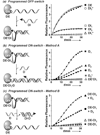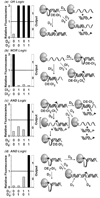Design of molecular logic devices based on a programmable DNA-regulated semisynthetic enzyme
- PMID: 17427900
- PMCID: PMC2790070
- DOI: 10.1002/anie.200700047
Design of molecular logic devices based on a programmable DNA-regulated semisynthetic enzyme
Figures




Similar articles
-
Mechanism-based profiling of enzyme families.Chem Rev. 2006 Aug;106(8):3279-301. doi: 10.1021/cr050288g. Chem Rev. 2006. PMID: 16895328 Review. No abstract available.
-
The general form of 0-1 programming problem based on DNA computing.Biosystems. 2003 Jun;70(1):73-8. doi: 10.1016/s0303-2647(03)00053-4. Biosystems. 2003. PMID: 12753938
-
Prediction of binding sites in receptor-ligand complexes with the Gaussian Network Model.Phys Rev Lett. 2008 Jun 6;100(22):228102. doi: 10.1103/PhysRevLett.100.228102. Epub 2008 Jun 3. Phys Rev Lett. 2008. PMID: 18643462
-
Transition state and multisubstrate analog inhibitors.Methods Enzymol. 1995;249:284-312. doi: 10.1016/0076-6879(95)49039-6. Methods Enzymol. 1995. PMID: 7791615 No abstract available.
-
Structural features of mammalian histidine decarboxylase reveal the basis for specific inhibition.Br J Pharmacol. 2009 May;157(1):4-13. doi: 10.1111/j.1476-5381.2009.00219.x. Br J Pharmacol. 2009. PMID: 19413567 Free PMC article. Review.
Cited by
-
Fabrication of Electrochemical-Based Bioelectronic Device and Biosensor Composed of Biomaterial-Nanomaterial Hybrid.Adv Exp Med Biol. 2018;1064:263-296. doi: 10.1007/978-981-13-0445-3_17. Adv Exp Med Biol. 2018. PMID: 30471039 Free PMC article. Review.
-
Hierarchical control of enzymatic actuators using DNA-based switchable memories.Nat Commun. 2017 Oct 24;8(1):1117. doi: 10.1038/s41467-017-01127-w. Nat Commun. 2017. PMID: 29061965 Free PMC article.
-
Modulating protein activity using tethered ligands with mutually exclusive binding sites.Nat Commun. 2015 Jul 22;6:7830. doi: 10.1038/ncomms8830. Nat Commun. 2015. PMID: 26198003 Free PMC article.
-
Engineering protein and DNA tools for creating DNA-dependent protein switches.Methods Enzymol. 2022;675:1-32. doi: 10.1016/bs.mie.2022.07.002. Epub 2022 Aug 23. Methods Enzymol. 2022. PMID: 36220266 Free PMC article.
-
Control of enzyme reactions by a reconfigurable DNA nanovault.Nat Commun. 2017 Oct 19;8(1):992. doi: 10.1038/s41467-017-01072-8. Nat Commun. 2017. PMID: 29051565 Free PMC article.
References
-
- Bieth J, Vratsanos SM, Wassermann N, Erlanger BF. Proc. Natl. Acad. Sci. U.S.A. 1969;64:1103–1106. M. A. Wainberg, B. F. Erlanger, Biochemistry 1971, 10, 3816–3819. - PMC - PubMed
- Berezin IV, Varfolomeev SD, Klibanov AM, Martinek K. FEBS Lett. 1974;39:329–331. - PubMed
- Corey DR, Schultz PG. J. Biol. Chem. 1989;264:3666–3669. - PubMed
- Westmark PR, Kelly JP, Smith BD. J. Am. Chem. Soc. 1993;115:3416–3419.
- Stayton PS, Shimoboji T, Long C, Chilkoti A, Chen G, Harris JM, Hoffman AS. Nature. 1995;378:472–474. - PubMed
- Liu D, Karanicolas J, Yu C, Zhang Z, Woolley GA. Bioorg. Med. Chem. Lett. 1997;7:2677–2680.
- Doi N, Yanagawa H. FEBS Lett. 1999;453:305–307. - PubMed
- Baird GS, Zacharias DA, Tsien RY. Proc. Natl. Acad. Sci. U.S.A. 1999;96:11241–11246. - PMC - PubMed
- Posey KL, Gimble FS. Biochemistry. 2002;41:2184–2190. - PubMed
- Liu H, Schmidt JJ, Bachand GD, Rizk SS, Looger LL, Hellinga HW, Montemagno CD. Nat. Mater. 2002;1:173–177. - PubMed
- Feliu JX, Ferrer-Miralles N, Blanco E, Cazorla D, Sobrino F, Villaverde A. Biochim. Biophys. Acta, Prot. Struct. Mol. Enzy. 2002;1596:212–224. - PubMed
- Looger LL, Dwyer MA, Smith JJ, Hellinga HW. Nature. 2003;423:185–190. - PubMed
- Dueber JE, Yeh BJ, Chak K, Lim WA. Science. 2003;301:1904–1908. - PubMed
- Guntas G, Ostermeier M. J. Mol. Biol. 2004;336:263–273. - PubMed
- Bose M, Groff D, Xie J, Brustad E, Schultz PG. J. Am. Chem. Soc. 2006;128:388–389. - PubMed
-
- Corey DR, Schultz PG. Science. 1987;238:1401–1403. - PubMed
- Uchiyama Y, Inoue H, Ohtsuka E, Nakai C, Kanaya S, Ueno Y, Ikehara M. Bioconjugate Chem. 1994;5:327–332. - PubMed
- Stojanovic MN, De Prada P, Landry DW. ChemBioChem. 2001;2:411–415. - PubMed
- Dittmer WU, Reuter A, Simmel FC. Angew. Chem. 2004;116:3634–3637. Angew. Chem. Int. Ed. 2004, 43, 3550–3553. - PubMed
- Simon P, Dueymes C, Fontecave M, Decout J-L. Angew. Chem. 2005;117:2824–2827. Angew. Chem. Int. Ed. 2005, 44, 2764–2767. - PubMed
- Choi B, Zocchi G, Wu Y, Chan S, Perry LJ. Phys. Rev. Lett. 2005;95:078102. - PubMed
- Pavlov V, Shlyahovsky B, Willner I. J. Am. Chem. Soc. 2005;127:6522–6523. - PubMed
Publication types
MeSH terms
Substances
Grants and funding
LinkOut - more resources
Full Text Sources
Other Literature Sources

